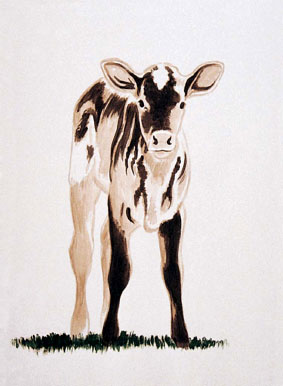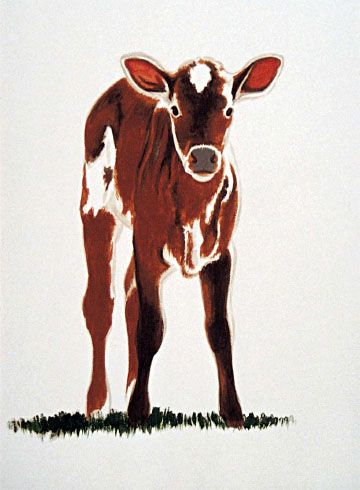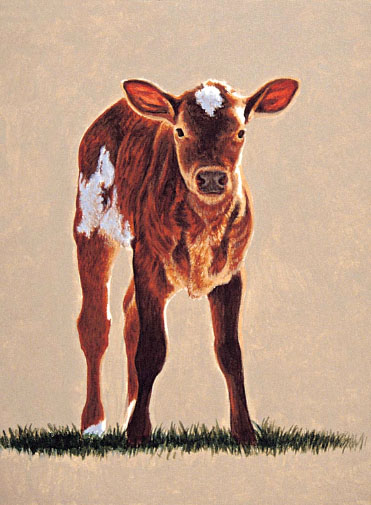Project 20: Calf
Last spring, this pretty calf was born to our part-longhorn cow, Aster. We named her Astrid. Her reddish coloring and white markings make her an attractive subject to paint.


Reference Photo
Materials
Paints
Burnt Sienna
Burnt Umber
Cadmium Orange
Cadmium Red Medium
Raw Sienna
Titanium White
Ultramarine Blue
Yellow Oxide
Brushes
no. 1, 3 and 5 rounds

1 Establish the Form and the Dark Values
With your pencil, lightly draw the calf onto the panel, using a kneaded eraser to lighten lines or make corrections. Use Burnt Umber thinned with water and a no. 3 round to paint the main lines of the calf.
Create a dark brown for the shadows using Burnt Umber, Burnt Sienna and Ultramarine Blue. Paint the dark parts of the calf with a no. 5 round, u sing a no. 1 round for the eyes and nostrils. Paint with smooth strokes that follow the calf’s contours. Dab the paint onto the forehead for the calf’s curly hair.

2 Paint the Middle Values
Mix a red for the coat with Burnt Sienna, Cadmium Orange and a small amount of Titanium White. Paint with a no. 5 round, switching to a no. 3 round for smaller areas.
Mix a pinkish color for inside the ears with Cadmium Red Medium, Cadmium Orange, Burnt Sienna and a small amount of Titanium White. Paint with a no. 5 round.
Mix a gray for the nose with Titanium White, Burnt Umber and Ultramarine Blue. Paint with a no. 3 round.

3 Paint the Light Values
Mix a buff color for the lighter parts of the calf with Titanium White, Raw Sienna and a small amount of Cadmium Orange. Paint with a no. 3 round, using strokes that follow the hair pattern.
For the shadows in the calf’s white markings, you’ll need a lighter, slightly bluish gray. Mix Titanium White and small amounts of Ultramarine Blue and Yellow Oxide. Paint with a no. 3 round, using dabbing strokes.

4 Paint Detail in the Coat
Transfer some of the dark brown from Step 1, some of the red from Step 2 and some of the buff from Step 3 to a dry wax paper palette. Use a no. 3 round and the dark brown to detail the coat with small, parallel brushstrokes that follow the hair pattern. Blend and soften with a separate no. 3 round and the red coat color. Use the same dark brown and brush to detail the buff-colored areas of the coat, then use a separate no. 3 round and the buff to blend.
Transfer a portion of the bluish gray from Step 3 to the dry palette. Mix a color for adding detail to the white areas of the coat with the bluish gray and small amounts of the dark brown and red. Paint with a no. 3 round.
Detail the nose with the dark brown and the gray from Step 2, using fresh no. 3 rounds for each.

ASTRID
Acrylic on Gessobord
10” × 8” (25cm × 20cm)
5 Add the Highlights and Finishing Details
On the dry palette, mix the highlight color for the calf with Titanium White and a bit of Yellow Oxide. Use a no. 3 round to paint with fairly thick strokes, then blend the edges with a separate no. 3 round and the red.
Use a no. 3 round and the red to add some lighter detail to the shadowed parts of the calf—the front legs, forehead, chest, etc. Use a moderately dry brush with light-pressured strokes. Using the same technique, paint some detail in the red areas of the coat with the buff color.
Paint the highlights in the eyes in small, curved arcs with a bit of the bluish gray and a no. 1 round. Use the same color and brush to paint highlights around the nostrils.
